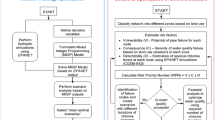Abstract
An optimization model is presented for pump operation based upon minimizing operation costs and indirectly the maintenance costs of pumps considering uncertainty of specified demand (load) curves. The purpose of this model is to determine pump operation to meet the uncertain demands as well as to satisfy the pressure requirements in the water distribution system. In addition, constraints on the number of pump (‘on-off’) switches are included as a surrogate to indirectly minimizing the maintenance costs. This model is a mixed integer nonlinear programming (MINLP) problem using a chance constraint formulation of the uncertain demand constraint. The optimization model was solved using the LocalSolver option in A Mathematical Programming Language (AMPL). The model was first applied to the operation of an example pumping system for an urban water distribution system (WDS) illustrating a reduction in operation costs using the optimization model. The optimization model with the chance-constraint for demand was applied for a range of demand satisfaction uncertainties. A decrease in the operation costs was observed with an increased uncertainty in demand satisfaction, which shows that the model further optimizes the operations considering the relaxed constraints. Model application could be extended to operations of pumping systems during emergencies and contingencies such as droughts, component failures etc.







Similar content being viewed by others
References
Barán B, von Lücken C, Sotelo A (2005) Multi-objective pump scheduling optimisation using evolutionary strategies. Adv Eng Softw 36(1):39–47. doi:10.1016/j.advengsoft.2004.03.012
Benoist T, Estellon B, Gardi F, Nouioua K (2010) Toward local search programming: LocalSolver 1.0. In: CPAIOR workshop: open source tools for constraint programming and mathematical programming, vol 49
Benoist, T., Estellon, B., Gardi, F., Megel, R. and Nouioua, K. (2011). LocalSolver 1. X: a black-box local-search solver for 0-1 programming. 4OR, 9 (3): 299–316. URL http://www.localsolver.com.
Boulos, P. F., Orr, C. H., De Schaetzen, W., Chatila, J. G., Moore, M., Hsiung, P., and Thomas, D. (2001). Optimal pump operation of water distribution systems using genetic algorithms. AWWA distribution system symposium. American Water Works Association, Denver
Boulos PF, Jacobsen LB, Heath JE, Kamojjala S (2014) Real-time modeling of water distribution systems: a case study. J Am Water Works Assoc:E391–E401
Brion LM, Mays LW (1991) Methodology for optimal operation of pumping stations in water distribution systems. J Hydraul Eng ASCE 117(11):1551–1569
Costa LHM, Ramos HM, Castro MAH (2010) Hybrid genetic algorithm in the optimization of energy costs in water supply networks. Water Sci Technol Water Supply 10:315
Fourer R, Gay DM, Kernighan BW (1993) AMPL: a modelling language for mathematical programming. The Scientific Press, San Francisco
Gay, D. M. (1997). Hooking your solver to AMPL. Technical report 93-10. AT&T Bell Laboratories, Murray Hill. 1993, revised.
Germanopoulos G, Jowitt PW (1992) Optimal pump scheduling in water-supply networks. J Water Resour Plan Manag 118(4):406–422. doi:10.1061/(ASCE)0733-9496(1992)118:4(406)
Ghaddar B, Naoum-Sawaya J, Kishimoto A, Taheri N, Eck B (2014) A Lagrangian decomposition approach for the pump scheduling problem in water networks. Eur J Oper Res 241:490–501
Goldman FE, Mays LW (2005) Water distribution system operation: application of simulated annealing. In: Mays LW (ed) Water resource systems management tools. McGraw Hill, New York
Goldstein R, Smith W (2002) Water & Sustainability (volume 4): U.S. electricity consumption for water supply & treatment - the next half century. Palo Alto, Electric Power Research Institute
Jamieson D, Shamir U, Martinez F, Franchini M (2007) Conceptual design of a generic, real-time, near-optimal control system for water-distribution networks. J Hydroinf 9(1):3–14
Kang D (2014) Real-time optimal control of water distribution systems, 12th International conference on computing and control for the water industry, CCWI 2013. Procedia Engineering 70, 917–923. Available online at www.sciencedirect.com
Kurek W, Ostfeld A (2013) Multi-objective optimization of water quality, pumps operation, and storage sizing of water distribution systems. J Environ Manag 115:189–197
Lansey KE, Awumah K (1994) Optimal pump operations considering pump switches. J Water Resour Plan Manag 120(1):17–35. doi:10.1061/(ASCE)0733-9496(1994)120:1(17)
Mays LW, Lansey KE, Tung Y, Duan N (1989) Water distribution system design under uncertainties. J Water Resour Plan Manag 115(5):630–645. doi:10.1061/(ASCE)0733-9496(1989)115:5(630)
Mays L, Tung Y-K (1992) Hydrosystems engineering and management. McGraw-Hill, New York
Ormsbee LE, Reddy SL (1995) Nonlinear heuristic for pump operations. J Water Resour Plan Manag ASCE 121(4):302–309
Richardson I, Thomson M, Infield D, Clifford C (2010) Domestic electricity use: a high-resolution energy demand model. Energy and buildings 42(10):1878–1887
Rossman, L. A. (2000). EPANET, User’s manual. U.S. Environmental Protection Agency, Cincinnati
Sakarya ABA, Mays LW (2000) Optimal operation of water distribution pumps considering water quality. J Water Resour Plan Manag ASCE 126(4):210–220
Shamir U, Salomons E (2008) Optimal real-time operation of urban water distribution systems using reduced models. J Water Resour Plan Manag ASCE 134(2):181–185
Van Zyl JE, Savic DA, Walters GA (2004) Operational optimization of water distribution systems using a hybrid genetic algorithm. J Water Resour Plan Manag 130(2):160–170. doi:10.1061/(ASCE)0733-9496(2004)130:2(160)
Wood, D. J. (1980). Computer analysis of flow in pipe networks including extended period simulations (KYPIPE). Office of Continuing Education, Univ. of Kentucky, Lexington
Zessler U, Shamir U (1989) Optimal operation of water distribution systems. J Water Resour Plan Manag ASCE 115:735–752
Author information
Authors and Affiliations
Corresponding author
Rights and permissions
About this article
Cite this article
Khatavkar, P., Mays, L.W. Model for Optimal Operation of Water Distribution Pumps with Uncertain Demand Patterns. Water Resour Manage 31, 3867–3880 (2017). https://doi.org/10.1007/s11269-017-1712-8
Received:
Accepted:
Published:
Issue Date:
DOI: https://doi.org/10.1007/s11269-017-1712-8




